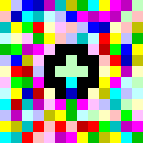Esoteric programming language
An esoteric programming language (sometimes shortened to esolang) is a programming language designed to test the boundaries of computer programming language design, as a proof of concept, as software art, as a hacking interface to another language (particularly functional programming or procedural programming languages), or as a joke. The use of the word esoteric distinguishes them from languages that working developers use to write software. The creators of most esolangs do not intend them to be used for mainstream programming, although some esoteric features, such as visuospatial syntax,[1] have inspired practical applications in the arts. Such languages are often popular among hackers and hobbyists.[citation needed]
Usability is rarely a goal for designers of esoteric programming languages; often their design leads to quite the opposite. Their usual aim is to remove or replace conventional language features while still maintaining a language that is Turing-complete, or even one for which the computational class is unknown.
The earliest, and still the canonical example of an esoteric programming language, is INTERCAL,[2] designed in 1972 by Don Woods and James M. Lyon, who said that their intention was to create a programming language unlike any with which they were familiar.[3][4] It parodied elements of established programming languages of the day such as Fortran, COBOL and assembly language.
For many years, INTERCAL was represented only by paper copies of the INTERCAL manual. Its revival in 1990 as an implementation in C under Unix stimulated a wave of interest in the intentional design of esoteric computer languages.
In 1993, Wouter van Oortmerssen created FALSE, a small stack-oriented programming language with syntax designed to make the code inherently obfuscated, confusing and unreadable. Its compiler is only 1024 bytes in size.[5] This inspired Urban Müller to create an even smaller language, the now-infamous Brainfuck, which consists of only eight recognized characters. Along with Chris Pressey's Befunge (like FALSE, but with a two-dimensional instruction pointer), Brainfuck is now one of the best-supported esoteric programming languages, with canonical examples of minimal Turing tarpits and needlessly obfuscated language features. Brainfuck is related to the P′′ family of Turing machines.
While esoteric programming languages differ in many ways, there are some common traits that characterize many languages, such as parody, minimalism, and the goal of making programming difficult.[6] Many esoteric programming languages, such as brainfuck, and similar, use single characters as commands, however, it isn't uncommon for languages to read line by line like conventional programming languages.

